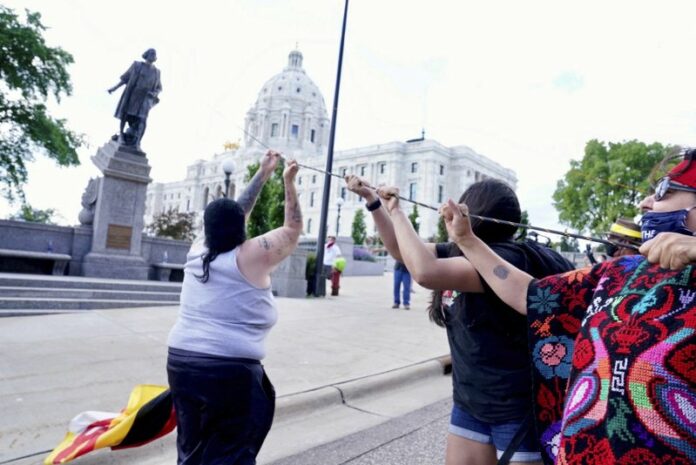
Christopher Columbus, King Leopold II, Winston Churchill, Edward Colston, Cecil Rhodes and the list goes on. Where will the toppling and defacing of the statues of racist historical figures end?
These past figures, an explorer, a king and leaders are now branded as ‘racist’, a disgrace which doesn’t deserve a place of pride in public in the United States, United Kingdom and Belgium. They are the latest targets of anti-racist Black Lives Matter movement. People are not content with condemning cops and current political leaders. They are going all the way to purge past figures and rewrite history.
Where do we draw the line amidst the growing list of the famous turning into the racist infamous? Being a slave trader as Colton was seems sufficient but what about mere historical figures who were racially prejudiced or kept black slaves in their time? How far should people go?
I am all for reassessing historical figures. But how should we go about doing it?
Think of Thomas Jefferson, for example. The principal author of the American Declaration of Independence and the third President of the United States is a slave owner – 600 African American slaves we are told.
This despite the famous phrase “all men are created equal” penned by Jefferson himself in the declaration in 1776. It was obviously hypocritical since he owned half a thousand black slaves. So should all his statues be toppled and removed or thrown down the river as well?
Shall we start with the demolition of Jefferson Memorial and its 4,500 kilogram bronze statue in Washington DC?
Or perhaps let’s rename Thomas Jefferson University, a private university in Philadelphia, with a more time-tested and politically correct figure?
Some historians counted as many as 12 past US presidents as slave owners, so what the hell was this “all men are created equal” slogan all about. And why black Americans are still struggling against racism nearly two and a half centuries after the declaration of independence was read?
I understand the anger, the sense of racial prejudice and injustice. The time for an end to racism in America and elsewhere are long overdue. But we should pause and ask ourselves to draw the limit of reassessing historical figures for their political correctness and even historical architectural structures.
For many Buddhists, the bombing of the Bamiyan Buddha statue by the Taliban in Afghanistan in 2001 was a sober reminder of how far some will go in trying to erase the past that they feel has no place in the present.
Taking this logic to the extreme, perhaps we might as well blow up Rome’s Colosseum since it could be seen as a reminder of Roman oppression, since some slaves and prisoners of war were forced to fight each other for entertainment nearly two millennia ago.
What about the Eiffel Tower? Should it not be demolished as well, since it was specifically built to project the engineering might of a cruel colonial France during the 1889 World’s Fair.
By that time, Algeria was already nearly six decades under French colonizers. French Indochina was formed in 1887, just two years before the unveiling of Eiffel Tower and would be followed by decades of racial tyranny.
France was an empire built on a belief of ethnic supremacy, and one could argue that the tower was thus a propaganda tool of colonial France. Back then it was the world’s tallest man-made structure at 314 meters to the tip and wouldn’t be surpassed for four decades until the Empire State building was unveiled in 1931 in New York. So perhaps it should have no place in today’s politically correct Paris.
Back to Jefferson in relations to France. Jeremy Black, author of ‘A Brief History of Slavery’ noted that the US President did not recognize Haiti when she first became an independent free-black republic in 1804.
“Jefferson had refused to extend diplomatic recognition to Haiti when it won independence in 1804, in part due to his wish for friendly relations with France, but largely as a product of racism.” Black wrote. “A black state proved too much for the influential slaveholding interests, for black republicanism was perceived as a serious threat to the racial order in America.”
The list of historical figures in need of reassessment can go on. You can pick your ‘favourite’ politically-incorrect historical figure, monument or architecture and argue for its destruction to satisfy the urge for political correctness or historical vengeance.
In Thailand, the past few months saw the statues of co-leaders of the People’s Party which led the 1932 revolt, chiefly that of Field Marshal Plaek Pibulsongkram, removed without explanation in Bangkok and Lopburi province.
In December 2018, a monument marking the defeat of Royalist rebels was also mysteriously removed from Laksi Circle in northwestern Bangkok.
Given its size and the government’s inabilities and unwillingness to provide any answer and accountability, the people behind the “historical reassessment” must indeed be very powerful.
I believe assessing history and historical figures is necessary, and even inevitable. But can there be a more civil and sensitive way in going about the process by not risking obliterating the past for the sake of the present’s political correctness?
History, after all, is not just about what we remember, but how we remember: the fact that we do not want to remember a certain past is a history in itself as well.











































